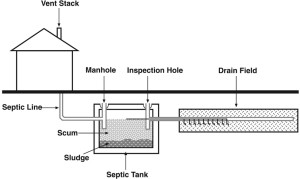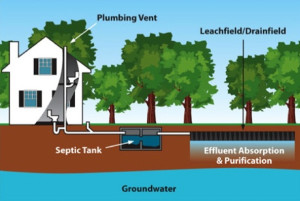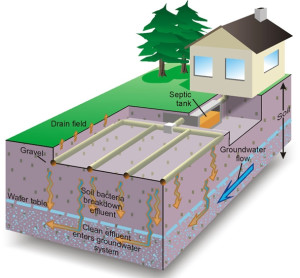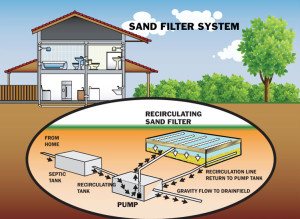Bannon Engineering provides septic system design in Vermont state-wide and in the Upper Valley area in New Hampshire. Mark Bannon is a class A1 Licensed Designer in Vermont and a Licensed Designer and Evaluator in New Hampshire. He was selected by Governor Shumlin in 2011 and continues under Governor Scott to serve as a Professional Engineer on the Vermont Department of Environmental Conservation Water and Wastewater Technical Committee. Mark is also a contributing member of the New Hampshire Granite State Onsite Wastewater Association. He is recognized as an expert in on-site water and wastewater design in New England and the Adirondacks.
Septic systems are common wastewater disposal systems, as not all towns operate sewer treatment plants.
How do septic systems work?
A standard septic system has six main parts:
- sewer pipe from the house to a septic tank,
- septic tank to settle solids and suspend oils,
- sewer pipe from the tank to the distribution box,
- distribution box to evenly distribute flows to each leg of the leach field pipe,
- leach field to drain the effluent water into the soil,
- soil to receive the effluent.
Septic systems work by receiving wastewater from the house. Toilets, washing machines, showers, sinks, and dishwashers drain to a central sewer pipe in the house. The sewer pipe drains to the septic tank. A septic tank is typically 1000 gallons and is built of steel, concrete, or plastic. A septic tank aims to separate solids from the wastewater and store and partially decompose as much solid material as possible while allowing the liquid effluent to go to the drain field.
The effluent is rich in nutrients, pathogens, viruses, and other materials. When the effluent drains into the soil, biological growth occurs. A biological mat grows on the soil that receives the effluent. This biological mat is important as it functions to treat the effluent. Biological activity reduces the nutrients, kills the pathogens, and filters out some viruses. The effluent continues to percolate through the soil, filtering along the way.
The depth of the soil plays an important role. The deeper the sims, the more filtration takes place. Most Codes require at least three feet of soil below the leach field pipes to the seasonal high-ground water. This allows the effluent to be treated sufficiently before it contacts the groundwater.
Ground water is used for drinking, so it is important that proper treatment takes place.
Why do septic systems fail?
The typical life of a septic system is 15 to 30 years. Septic systems fail naturally as the biological mat under the leach field pipes thickens. At some point, the biological mat becomes so thick that water can no longer flow through it. The most common failure Bannon Engineering sees in older systems is clogging of the bio-mat, causing ponding in areas of the leach field.
How to prolong the life of your septic system?
A failing system can become a source of pollution and public health concern, causing property damage, ground and surface water pollution (such as well water—yours and your neighbors), and disease outbreaks. Once your septic system fails to operate effectively, you may need to replace it, costing you thousands of dollars. Plus, if you sell your home, your septic system must be in good working order. Therefore, it makes good sense to understand and care for your septic system.
Owners can prolong the life of their septic systems by
- Using less water,
- spreading the use of water out, e.g., small loads of laundry spread over a week vs many loads in one day,
- pumping their septic tank every three years,
- use bleach sparingly. Bleach kills the biological activity, and the dead biology thickens the biota, causing clogging,
- do not dispose of chemicals or excess organic matter, such as that from garbage disposal in a septic system, and
- driving heavy equipment over a septic system.
Septic System Design for New Construction and Failed Systems
Bannon Engineering designs septic systems in Vermont, New Hampshire, and the Cranberry Lake area in the Adirondacks. We offer both conventional septic system designs along with innovative mound-type septic fields and pre-treatment alternative septic designs. We have experience designing affordable systems for really, really tough sites. Contact us for assistance.




